Part 4: Reviewing the components of central government's financial management system
4.1
In this Part, we set out the approach used to assess the state of financial management practice. This assessment was completed in February 2012, and summarises the main observations.
The review methodology
4.2
Reviewing the effectiveness of financial management in central government involves understanding how the demand for, and supply of, financial management affect the four financial management practices of budget management, financial controls, value management, and governance and accountability.
4.3
This approach is summarised in Figure 4.
Figure 4
Factors that affect the demand and supply of strong financial management
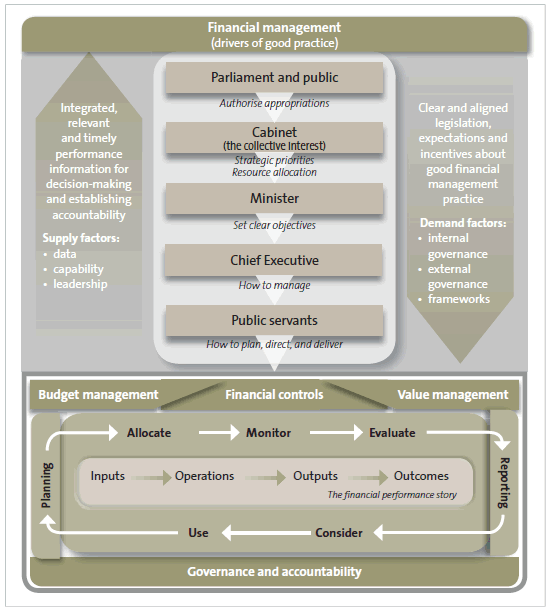
4.4
We used interviews and working group discussions with officials, chief executives, and CFOs in government agencies, and applied the maturity model scale illustrated in Figure 5 to describe central government's overall standing in each of the four practices of financial management (as set out in Part 2).
Figure 5
Maturity model scale
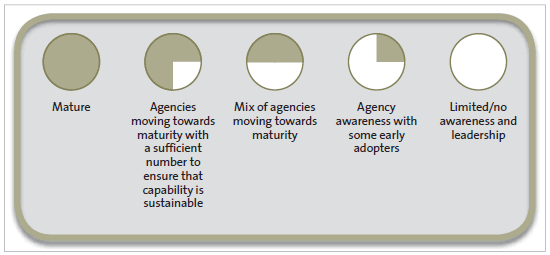
4.5
The following sections summarise our main observations about the strengths and weaknesses of each of the six demand and supply-side drivers of financial management shown in Figure 4, and what these mean for the four practices of financial management.
4.6
The practice of value management is assessed at an organisational and a system (or whole-of-government) level.
The framework for financial management
4.7
This includes the legislation and regulations governing financial management, which set requirements for budget management, monitoring and control, and value management.
4.8
Although the current frameworks set clear expectations and accountabilities for financial management in individual public sector entities, they do not easily allow for collaborative work between public sector entities where budgets and resources need to be reallocated to support projects.
Figure 6
Stage of maturity – Frameworks
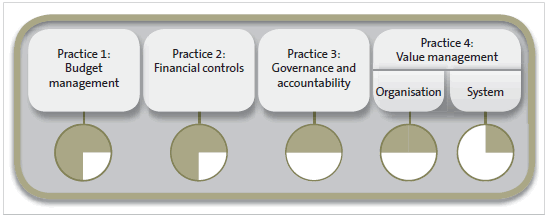
4.9
Strengths of frameworks are:
- Legislation and guidance is evolving and spans the breadth of financial management, providing clear rules and expectations for, among other things, value management practices.
- Budget management, financial controls, and external reporting are integral parts of public sector financial processes.
4.10
Limitations of frameworks are:
- Government includes a wide range of agencies with different organisational roles, mandates, and capacity. The size and breadth of each organisation's role can significantly affect how it can introduce financial management practices and prerequisites.
- The previous short-term focus of the frameworks governing planning, budgeting, performance, and reporting may adversely affect public entities' capability for longer-term and more strategic financial management.
- The required planning documents (for instance, Statements of Intent) provide a mechanism to support reporting but not for encouraging or achieving value management practices.
- Although value management is fundamental to the budget process, the budget process alone cannot stimulate value management.
4.11
Recent initiatives for frameworks include:
- Budget 2011 introduced Four-year Budget Plans (capital and operating), including identifying low-priority spending and significant options for reprioritisation.
- Introduction of Better Administrative Support Services, which provides benchmarking services to support VFM assessments, target-setting, and tracking of improvement over time.
- Introduction of the Cross Agency Initiatives Process to support assessing of, and investing in, work involving more than one public entity.
External governance
4.12
External governance covers the structures and processes involved in addressing the stewardship role of, and accountability to, external stakeholders such as Ministers, Parliament, and the public. Among other things, external governance is supported through the quality of the help and guidance that central government agencies provide.
4.13
External stakeholders will always have different perspectives. The inherent tensions that result are a fundamental part of the fabric of government. The tensions can be a source of strength and weakness for the financial management system, which, therefore, must be managed to ensure that it reflects, but does not seek to represent, every perspective.
4.14
Although public entities have at times been clear in their demand for, and focus on, wider financial management, their effective focus has been largely on budget management, financial controls, and external reporting. This has played a part in narrowing the practice of financial management throughout government.
Figure 7
Stage of maturity – External governance
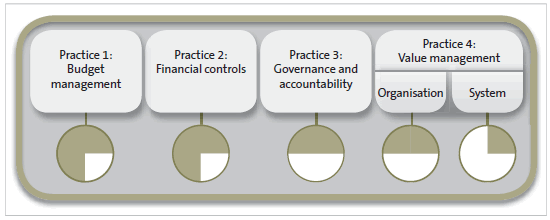
4.15
Strengths of external governance are:
- Central agencies and the Auditor-General have clear and specific responsibilities for financial and performance management practices.
- A significant suite of guidance material has been produced and published by central agencies and the Auditor-General.
- There is established support and advice to agencies for budget management and control.
4.16
Limitations of external governance are:
- The Treasury and the State Services Commission have discrete responsibilities for aspects of financial management, but have unclear roles and accountabilities in value management and the overall financial performance of public entities.
- Central government agencies' financial management focus and accountability processes are heavily weighted towards budget management, financial controls, and external reporting.
- Apart from publishing and disseminating guidance and setting up information sharing forums, there is little building of public entities' capability and understanding of strong financial management practice.
- There appear to be no visible consequences (or benefits) for chief executives (or the agencies themselves) for poor (or strong) financial management practice.
4.17
Recent initiatives for external governance include:
- The processes and structures supporting the Better Business Case Guidance begin to move guidance material away from being static documents towards more interactive opportunities for growing capability.
- The publication of the Investment Statement of the Government of New Zealand provides an overview of the significant assets and liabilities on the Crown's balance sheet, how they have changed over time, and how what the Crown owns and owes is forecast to change over the next five years.
Internal governance
4.18
Internal governance considers the structures, processes, and accountabilities that the executive of the agency uses to manage and overview the organisation.
4.19
Internal governance processes, such as the development of strategy, planning, and budgeting, should translate the strategic intent of the organisation into activity. This translation should be the subject of internal controls to determine whether it is providing value for money.
4.20
Internal governance throughout government is generally effective and provides robust assurance for, and oversight of, the financial management practices of budget management and financial control.
4.21
However, governance and accountability in relation to value management is unclear and confused. There was often a lack of internal processes to help understand and establish accountability for achieving the practices, prerequisites and outcomes of strong financial management.
Figure 8
Stage of maturity – Internal governance
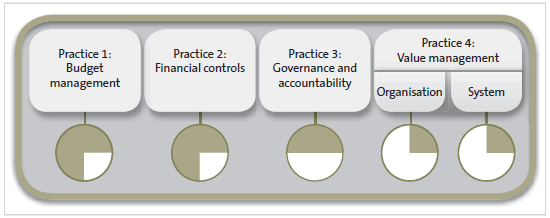
4.22
Strengths of internal governance are:
- There are generally sound structures and accountabilities in place to effectively govern budget management and financial controls.
- A few public entities have combined accountabilities for planning, preparing strategy, budgeting, reporting performance, and improving business.
4.23
Limitations of internal governance are:
- Accountabilities for planning, preparing strategy, budgeting, reporting performance, and improving business are often split among many teams and throughout the organisation.
- Budgeting and planning processes are often not in line with time frames.
- Output specifications are often not linked with the planning and budgeting process.
- VFM and cost-effectiveness projects are often set up as one-off initiatives rather than part of core (business as usual) accountabilities.
- Financial management is limited by the creation and/or existence of many governance structures with unclear mandates, accountabilities, ownership, memberships, and insular reporting requirements.
- The risk management and analysis done through governance structures is not proportional to the risk and expenditure or linked activities involved in delivering services.
Leadership
4.24
Leadership looks at the degree to which senior officials in the public sector influence, motivate, and appreciate strong financial management.
4.25
Leaders acknowledged and strongly supported the need for better financial management, especially value management. However, they were not always clear what this meant in practice or what strong practice looked like. Financial management and developing capability in their organisations was not always a top priority for many public sector leaders, who often focus more on managing policy and the political environment.
Figure 9
Stage of maturity – Leadership
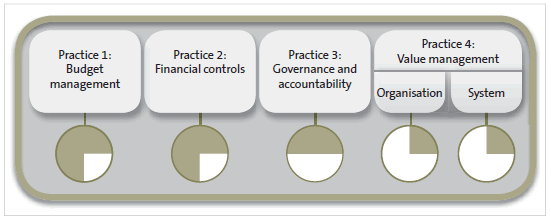
4.26
Strengths of leadership are:
- Most leaders recognise that current financial pressures mean that it is most important to focus scarce resources on priority areas and significantly improve efficiency and effectiveness.
- Many leaders have stated that their organisations have made progress in understanding what is valuable to them and in identifying VFM gains as they arise.
4.27
Limitations of leadership are:
- Most leaders recognise that their organisations have to make significant changes to fully understand and embed the full set of financial management practices. Limitations include lack of:
- capability;
- integrated business intelligence and data;
- awareness of responsibilities that cover more than one public entity; and
- wider organisational understanding of how to assess and achieve VFM.
- Some leaders see the current VFM focus as temporary and more about other sectors and spending that is unrelated to their organisation.
4.28
Recent initiatives for leadership include:
- Budget 2011 announced that agencies would be required to deliver an "efficiency dividend" of between 3% and 6%, depending on the size of the agency. This dividend is intended to drive ongoing efficiency and productivity improvements and to generate savings alongside the move to four-year budget plans.
- In September 2010, the Performance Improvement Framework was introduced as an evaluation of practices, systems, and processes in public entities. The evaluation includes assessing leadership, direction and delivery, and financial and resource management. The financial and resource management section is being upgraded to recognise, among other things, the benefits of sustained integration and use of performance information.
Capability
4.29
Capability refers to the skills and experience that provide capacity within the public sector to perform good financial management.
4.30
Most agencies have the skills and competence needed for budget management and financial controls. However, few have the skills and experience required for the full set of financial management practices at both agency and system levels.
4.31
The role of the CFO needs to be moved from that of Financial Controller (focusing on budgets and controls) to that of "Chief Performance Officer", focusing on value management and financial performance, in line with leading private-sector practice.
Figure 10
Stage of maturity – Capability

4.32
Strengths of capability are:
- In general, finance teams are able to manage budgets and control finances well.
4.33
Limitations of capability are:
- In most public sector organisations, the CFO is a "financial controller" whose focus is on managing budgets and reporting rather than value management, improving performance, or being an agent of change.
- Few CFOs and finance teams have the mandate, capability, or capacity to carry out some more sophisticated financial management, such as cost-benefit analysis, VFM or efficiency assessments, process design, or re-engineering techniques.
- Many CFOs lack the experience of building the required systems, processes, and finance teams to introduce and incorporate value management practices.
- Outside finance teams, financial literacy and capability is limited.
4.34
Recent initiatives for capability include:
- The Treasury holding a CFO forum to share good practice and methods among public entities.
- Improved functional leadership responsibilities through the Government Chief Information Officer and centres of expertise for managing property and procurement.
Systems, processes, and data
4.35
This section examines the "infrastructure" needed to manage finances within and throughout government.
4.36
The systems, processes, and data required to manage a public sector entity's budget and control its finances are generally sound. However, in general, the requirements for value management are not supported well. Often, planning and budgeting processes and accountabilities were weakly in line with, and separated from, the preparing and defining of strategy.
4.37
Ernst & Young's experience working with government organisations suggests that, in general, a lack of process and/or managers' initiative, rather than the systems' capabilities, is responsible for these weaknesses.
Figure 11
Stage of maturity – Systems, processes, and data
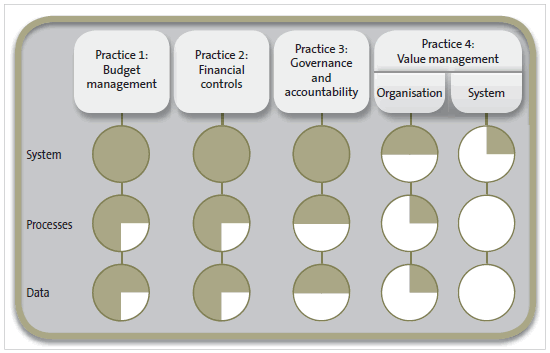
4.38
Strengths of systems, processes, and data are:
- Most public entities' information systems can support sound financial management.
- Often, sector and system outcome data is good.
- Budgeting and external reporting processes are robust.
4.39
Limitations of systems, processes, and data are:
- Few public entities seek to collect reliable data about how and where resources are used and the cost of the services delivered, meaning that VFM cannot be understood.
- Financial and non-financial output performance data is generally weak.
- Often systems are not used to their full capabilities.
- Planning and budgeting are not always in line with work on strategy.
- Scrutiny of investment and divestment is largely limited to capital expenditure.
- Procurement practices tend to be heavily focused on probity and compliance with process rather than the effectiveness, value, and purpose of the spending.
- In general, there are no (or cumbersome) processes to support the financial management of more than one public entity.
4.40
Recent innovations include:
- changes to improve the quality of capital investment decisions through the Treasury's Better Business Case process. These are a positive step in carrying out a more sophisticated analysis of costs and benefits of significant spending.
